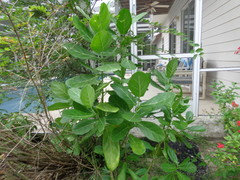Giant Milkweed (Calotropis Procera)
Tom
8 years ago
Featured Answer
Sort by:Oldest
Comments (50)
kaboehm (zone 9a, TX USA)
8 years agoTom
8 years agolast modified: 8 years agoRelated Discussions
Milkweed ID
Comments (10)As I understand it (and from a packet I got from the Wings and Wildflowers festival), sage seeds are TINY. I would imagine the means of seed collection is much like coleus. Grab an envelope, open it and shake the dried flowers into it. For myself, I just cleared out a small bed around my sage and I'm letting it self-seed the area, hopefully. Also, as a point of interest, you can usually type these questions into google and you will find an article on eHow or some other site telling you how to do it. So try typing, "how to collect sage seeds" and let 'er go! Though, I admit, sometimes I like to hear it from my fellow Floridian Gardeners. I trust them more....See MoreWANTED: Calotropis gigantea giant milkweed
Comments (1)I would like to know how to propagate Giant Milkweed. I have the Gigantea viariety which DOES NOT produce seeds nor is fragrant compared to the Calantropis procera. The gigantea is the one that is velvety, with felt like leaves instead of the green leaves of the Procera. I researched for propagation for a long time but the information about the Procera and the Gigantea are mixed up. When looking up the propagation, they talk about the seeds of the Procera that the Gigantea does not have. Has anybody had success with cuttings and if yes how was it done? Thank You very much. Nathalie...See MoreCalotropis Gigantea - Giant Milkweed Crown Flower
Comments (3)I just now noticed my error. I should have asked about C procera as that is the plant I had in mind. I have since discovered Calotropis Gigantea and Calotropis procera are two different plants. Thank you for this helpful information. I think my area gets more cold so I'm not certain I could over winter one here in my greenhouse as I only keep night temps at about 40 degrees through the coldest months. Although if I ever get hold of one of these plants, I'd really like to give it a try. Like Common Milkweed, the size of the leaves are so inviting where garden space is so limited. Common Milkweed usually becomes too ragged here in my garden by late summer to feed the fall migration, as do most of the native milkweeds I grow. May I ask, did you start your plant by seed? My thanks again for taking the time to comment. Mary...See Morelooking for Calotropis Procera seeds
Comments (1)If you can't wait, SmartSeeds has them available right now. I bought my C. procera seed from her last year, plus one or two others. 100% germination, she has some of the finest seed around. My plants are returning from the brink of death (not too long a story...) now that the weather is warming up. If they set seed later in the year, you may have some. In your zone, you will definitely need to overwinter them or else they'll freeze. From what I've read, they can freeze to the ground, but may sprout back up the next season. A Milkweed Tree To Feed Them All...See MoreMary Leek
8 years agolast modified: 8 years agoTom
8 years agokaboehm (zone 9a, TX USA)
8 years agoTom
8 years agolast modified: 8 years agokaboehm (zone 9a, TX USA)
8 years agolast modified: 8 years agombz10b
8 years agoTom
8 years agombz10b
8 years agoMonarch Love
8 years agokaboehm (zone 9a, TX USA)
8 years agoTom
8 years agokaboehm (zone 9a, TX USA)
8 years agoTom
8 years agoMary Leek
8 years agoFlamingo Road Nursery
8 years agobossyvossy
8 years agoFlamingo Road Nursery
8 years agodocmom_gw
8 years agobossyvossy
8 years agoMissSherry
8 years agoTom
8 years agoMary Leek
8 years agoTom
8 years agoFlamingo Road Nursery
8 years agoTom
8 years agoMary Leek
8 years agokaboehm (zone 9a, TX USA)
8 years agoTom
8 years agoMary Leek
8 years agoMary Leek
8 years agoTom
8 years agocghpnd
8 years agobarbi1019
8 years agoCrunch Hardtack
8 years agoTom
8 years agoCrunch Hardtack
8 years agocghpnd
8 years agoLena Hall
8 years agokaboehm (zone 9a, TX USA)
8 years agoCrunch Hardtack
8 years agokaboehm (zone 9a, TX USA)
8 years agoCrunch Hardtack
8 years agoMary Leek
8 years agosorie6 zone 6b
8 years agoCrunch Hardtack
8 years agoHU-347057496788
5 years agoGrowInFlorida
5 years ago
Sponsored
Zanesville's Most Skilled & Knowledgeable Home Improvement Specialists
More Discussions






joncongaroo